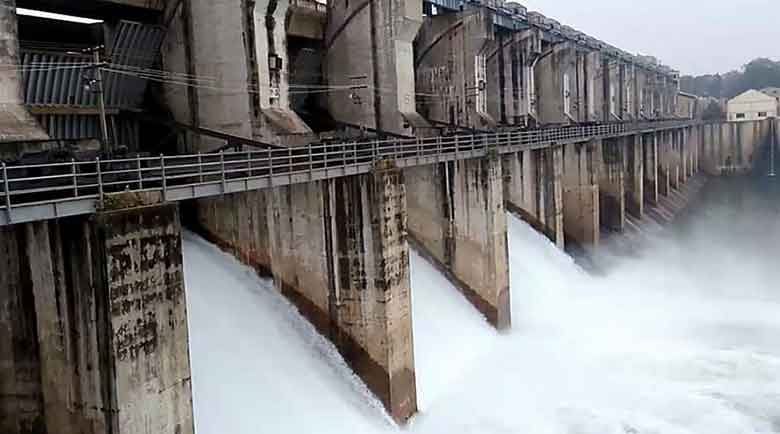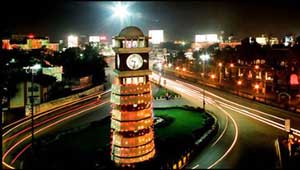Struggle for rehabilitation: Gangrel’s displaced communities
Dhamtari | Correspondent: Dhamtari district soon to organize ‘Jal-Jagar Mahotsav’, an initiative towards water conservation.
A two-day event to be conducted on the banks of the life-giving Mahanadi River in Gangrel, located in the Dhamtari district, on the 5th and 6th of October.
While the government prepares to celebrate a grand festival at Gangrel Dam, the sorrow of displaced families continues to echo in silence.
Forgotten by time, their third generation still waits, with hope fading, for the compensation and rehabilitation they were promised.
These families, once uprooted from their land, have been left to bear the burden of unfulfilled promises, even as festivities flourish on the very soil, they once called home.
Five decades later, tribal rehabilitation still incomplete
Even after 50 years of struggle the situation remains unresolved, as the rehabilitation process has not been completed despite the order from Chhattisgarh High Court.
Over the years many tribal lives were lost in their struggle for justice. However, even after five decades the rehabilitation of these tribal lives remain incomplete.
Some villagers were allotted lands in Bagador also known as Jogidih village, but to this day, their lands have not been located. Similar challenges persist in other villages as well.
For instance, Sonabai wife of Ramakrishna Rao, was allotted Khasra numbers 192-193, while Anjana Bai wife of Hirasingh Rao was granted Khasra numbers 194-195. Similarly, Vaman Rao was allocated Khasra numbers 261-262, but he has no knowledge about its location. The tehsil office claims that the file pertaining to his land is missing from their records.
The state government has consistently denied that any rehabilitation cases are still pending. The government kept citing the lack of rehabilitation rules at the time of displacement. This approach continued from the era of undivided Madhya Pradesh to the formation of Chhattisgarh.
However, when the case was brought before the court, more layers of the issue began unfolding.
Gangrel Dam: ongoing struggle for rehabilitation
The foundation stone of this dam with a capacity of 32.150 TMC was laid on 5 May 1972 by the then Prime Minister Indira Gandhi.
The construction of this dam, spanning the undivided districts of Raipur, Kanker and Durg displaced residents from 52 revenue and 3 villages.
The 55 villages include Gangrel, Chanwar, Tasi, Teluguda, Bargari, Kodegaon, Mongragahan, Singhola, Bhilai, Machandur, Barbandha, Silatra, Satiara, Chapgaon, Kokadi, Tumabujurg, Koliari, Tirra, Chikhli, Kohka, Mategahan, Tumakhurd, Mudpar, Koralma, Pataud, Harfar, Bhaismundi. 16704.2 acres of land of these villages got submerged in this dam forever.
The state government consistently claimed that by 1978, all affected individuals, except a man named Manglu, had received compensation.
According to official records, Mangalu filed a petition in undivided Madhya Pradesh in 1986, and as per the court’s directions, he too was compensated.
The government argued that at the time, there was no rehabilitation policy in place, apart from compensation under the Land Acquisition Act of 1894. It was only in 2007 that a policy was introduced to provide compensation or employment to those who lost their land.
The Gangrel Dam project, however, was completed between 1972 and 1978. Despite this, the government claimed to have provided benefits to the displaced from all 55 villages to the best extent possible.
Although compensation was paid, and some families were resettled in Jogidih village, hundreds of displaced people remained in search of proper rehabilitation.
Petition Filed Over Unpaid Compensation for Gangrel Dam Outsees
A total of 8,560 families affected by the construction of the dam filed a petition in the Jabalpur High Court, seeking rehabilitation and compensation.
Later, the people displaced by the dam, fed up, filed separate petitions in Chhattisgarh High Court in 2008 and again in 2016. In 2008, Gangrel Dam Prabhutti Jan Kalyan Samiti filed a petition and in 2016, a case was filed on behalf of 50 displaced people.
The Chhattisgarh government argued that at the time when land was acquired for the construction of Gangrel Dam, a notification dated 29.1.1976 was issued by the then government. There was a circular of the Revenue Department in Madhya Pradesh, which provided that if any agricultural land is required for irrigation, then the affected land-displaced people will be given agricultural land as far as possible and on the basis of this circular, in the year 1979-80, 99 land-displaced people were given agricultural land as per their demand according to the availability of agricultural land. Other land-displaced persons received compensation and moved and settled elsewhere.
A meeting was held on 19.3.1978 under the chairmanship of Parliamentary Secretary, Revenue Department, which was attended by officers of various departments. Another letter dated 29.5.1978 addressed to the Superintending Engineer, Mahanadi Irrigation Project, Rudri by the Sub-Divisional Officer, Dhamtari also shows that instructions were received from the Government for rehabilitation of the displaced persons and for this purpose the Government was required to conduct a survey to know the number of affected families.
Despite these efforts, the terms and condition of this rehabilitation policy were clearly not mentioned in the in the letter, nor was there a comprehensive policy in place. The only guideline available was a limited provision from 1976 about allotting agricultural land.
In a letter dated June 3, 1978, the Sub-Divisional Officer of Dhamtari informed the Executive Engineer of the Mahanadi Project in Rudri that the Raipur Collector had set a final deadline of June 5, 1978, to allocate abadi plots to families displaced by the Gangrel Dam at Bagodor village. Once the land was allotted, the rehabilitation process was expected to begin.
The Executive Engineer was asked to collect the details of the displaced families. On November 11, 1978, a meeting was held to discuss the issues arising from the displacement caused by the Gangrel Dam, including the rehabilitation of landowners. This meeting, chaired by the Commissioner of Raipur Division, was attended by key officials, including the Collector, Additional Collector, and representatives from the Forest, Irrigation, and Land Acquisition Departments.
During the meeting, it was decided that the displaced people would be rehabilitated according to a circular issued on January 29, 1976. Land from the Revenue Department in nearby villages would be used for this purpose. The Collectors of Raipur, Durg, and Kanker districts were instructed to act quickly and report on the progress.
Instructions for Forest Land Transfer
The proposal also included steps to transfer 889 hectares of forest land to the Revenue Department for the purpose of providing land to the displaced persons, specifically those whose land had been acquired. This plan aimed to create a rehabilitation strategy for villages like Bagodor and Salooni.
It was noted that the 889 hectares of forest land might not be enough to accommodate all displaced individuals. Therefore, the forest divisions of Raipur, Kanker, and Durg were directed to conduct a survey to assess whether additional land could be found for rehabilitation purposes.
These documents reveal that the displaced persons were not only entitled to agricultural land but also to a broader rehabilitation plan. While the circular dated January 29, 1976, only provided for land allocation, additional benefits were being planned as part of the rehabilitation process.
To this end, the process of transferring the 889 hectares of forest land was initiated, pending approval from the Central Government. However, this approval was never granted, and the transfer ultimately did not occur.
During this period, land was allotted to 159 displaced persons in Bagodor (Jogidih), and many other applications were under review. The government claimed that in 1979-80, agricultural land was allocated to 99 land-displaced individuals. Later, after a petition was filed in the Chhattisgarh High Court, an additional 71 people were granted land between 2009 and 2010 by revenue officials.
Chhattisgarh High Court’s Ruling
On December 16, 2020, Justice M.M. Srivastava delivered the court’s verdict. The court noted that if no further land allotments had been made after 1980, the petitioner could not demand land allocation without proof of having submitted a formal request under the 1976 circular. However, since a second phase of allotments occurred from 2004 to 2010, during which 70 displaced individuals received land, the situation had changed.
The court emphasized that the state government cannot selectively grant rehabilitation benefits. The ‘pick and choose’ approach is not permissible. If 70 landless persons had been allotted land, then the petitioners, who were also landless, had an equal right to be considered for rehabilitation. They could not be denied simply because they had not submitted a demand letter at the time of land acquisition and compensation, as required by the 1976 circular.
The court directed that the cases for land allotment to the petitioners should be reviewed by the Collectors of Durg, Dhamtari, and Kanker districts. It also instructed that the process for granting land leases should be initiated by the appropriate authority under the orders of the respective Collectors.
Finally, the court ruled that if the allotments made between 2004 and 2010 are not cancelled, the petitioners’ claims for land will be examined by the competent revenue authorities within three months.
Action, not ceremonies- Gautam Bandopadhyay, River Expert
Gautam Bandopadhyay, a river conservationist, expressed concern to CGKHABAR regarding the upcoming water conservation Mahotsav, suggesting it is serving more as a distraction from the critical water issue of water scarcity than a genuine effort to address it. He highlighted that many families still await assistance with their applications for rehabilitation, emphasizing the urgent need for scientific planning and action. Illegal encroachments and rampant sand mining are choking rivers across Chhattisgarh, leading to significant environmental degradation. Bandopadhyay noted that while major rivers suffer, smaller ones are at risk, with little being done to combat illegal activities and restore the affected waterways.
He further criticized the government’s approach, stating that the festival risks becoming a facade for ongoing destruction rather than raising awareness. Bandopadhyay called for meaningful discussions and the development of robust water and river management policies, stressing that rivers cannot be saved through ceremonial acts alone. He urged for sustainable and equitable actions that consider the needs of both the environment and local communities, advocating for genuine conservation efforts to ensure the survival of rivers for future generations.




